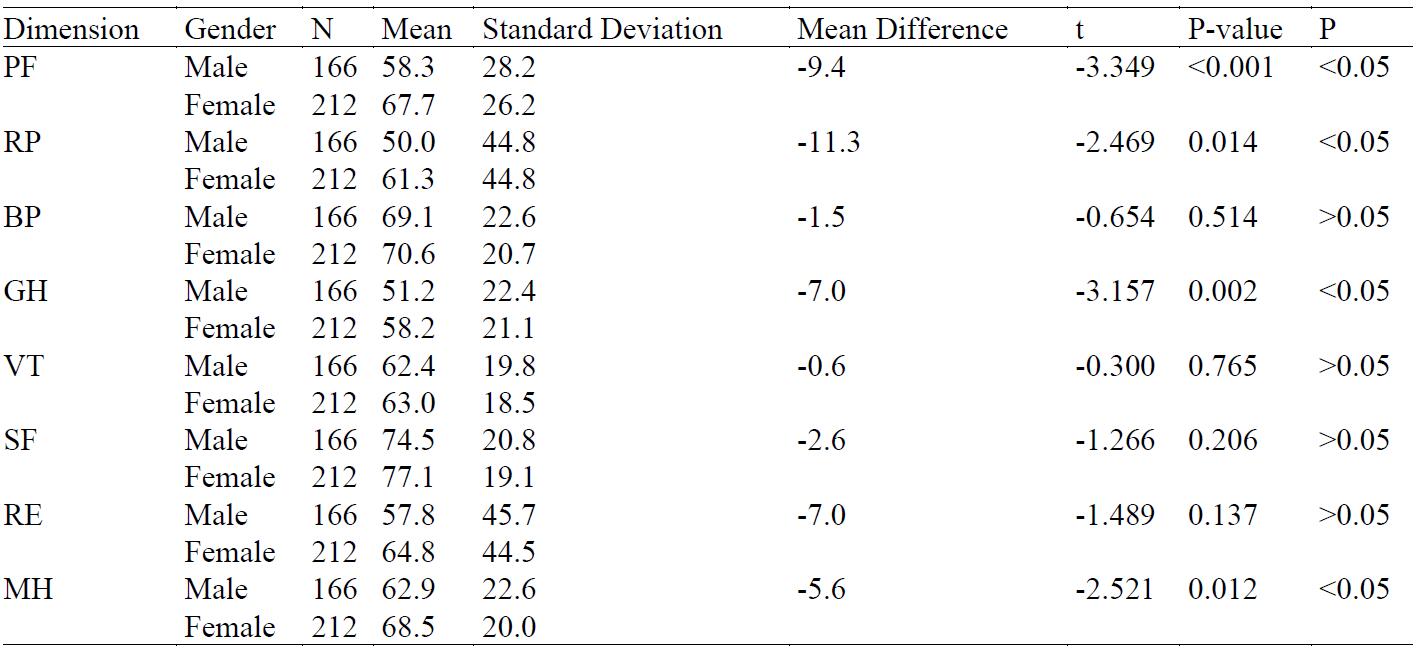Home-based vs. Nursing Home Care: A Comparative Study on the Quality of Life of the Elderly in Nantong
Abstract
Background: China’s aging population underscores urgent challenges in elderly care. In this study, quality of life (QoL) and nutritional status were compared between elderly populations in home-based and nursing home care to inform care strategies. Methods: A stratified random sample of elderly residents in the Chongchuan, Nantong, was assessed using online and offline questionnaires. The data were analyzed using SPSS 27.0. Results: Nursing home residents exhibited significantly lower QoL across all dimensions than home-based elderly. Female elderly exhibited significantly higher mean scores across all QoL dimensions than males. Individuals aged 60–69 years scored higher across all dimensions than the other age groups. Academic qualifications significantly influenced two dimensions, with higher academic qualifications associated with better outcomes. Pre-retirement occupation showed significant effects on four dimensions, although no inter-occupational differences were observed. Income significantly impacted one dimension, with higher income correlating with a better QoL. Significant effects of marital status were observed. Frequency of contact with children only influenced one dimension, with no differences across contact levels. Chronic diseases significantly affected all dimensions. Home-based elderly individuals had higher Mini Nutritional Assessment Short-Form (MNA-SF) scores than nursing home residents. MNA-SF scores showed significant positive correlations with all QoL dimensions. Conclusions: The higher QoL and nutritional status of home-based elderly individuals compared to nursing home residents was attributed to stronger family support, greater autonomy, and familiar environments. Care setting selection should consider health status and family support. Interventions targeting mental health, social interactions, and nutrition are essential for improving QoL in nursing homes.
References
[2] World Health Organization. (2022). Global strategy and action plan on ageing and health. Geneva: WHO Press.
[3] Research on the relationship between loneliness, social isolation, and quality of life among elderly under different elderly care models and intervention models [D]. Chongqing Medical University. (2021).
[4] Zhong, X., Wu, J., Ma, L., Liu, J., Huang, F., & Liu, G. (2021). Relationship between chronic diseases and quality of life among elderly in nursing homes. Journal of Shihezi University Natural Science Edition, 6.
[5] Li, H., & Brown, T. (2020). Chronic illness and quality of life in older adults: A global perspective. International Journal of Environmental Research and Public Health, 17(15), 6789. https://doi.org/10.3390/ijerph17186789
[6] Kim, S., & Park, J. (2021). A systematic review of home-based care models. Nutrients, 13(4), 1234. https://doi.org/10.3390/nu13041234
[7] Chen, X., & Zhang, W. (2019). Education and quality of life in older adults: A meta-analysis. Social Science & Medicine, 230, 1–10. https://doi.org/10.1016/j.socscimed.2019.04.016
[8] National Bureau of Statistics. (2023). China aging population development report. Beijing: China Statistics Press.
[9] Bató, A., Brodszky, V., & Rencz, F. (2025). Development of updated population norms for the SF-36 for Hungary and comparison with 1997–1998 norms. Health and Quality of Life Outcomes, 23, 14. https://doi.org/10.1186/s12955-025-01913-5
[10] He, Y., Jian, Z., Ouyang, M., & Peng, W. (2004). Comparison of MNA and MNA-SF in assessing nutritional status among elderly individuals. Practical Geriatrics, 18, 43–45.
[11] Jiang, M., Li, L., & Wang, H. (2025, January 27). SF-36 v2 Scale Chinese population norm study. In Proceedings of the Third Academic Conference of the Chinese Preventive Medicine Association and the Award Ceremony of the Chinese Preventive Medicine Association Science and Technology Award, First Western Pacific Regional Public Health Conference of the World Federation of Public Health Associations, and Fifth Annual Conference of the Global Chinese Public Health Association.
[12] Hedayati, H., Hadi, N., Mostafavi, L., Akbarzadeh, A., & Montazeri, A. (2014). Quality of life among nursing home residents compared with the elderly at home. Shiraz E-Medical Journal, 15(10), e22718. https://doi.org/10.17795/semj22718
[13] Wang, J. (2012). A comparative study of attachment and loneliness between urban home-based elderly and nursing home residents. Master’s thesis, Sichuan Normal University.
[14] Clark, P., & Bowling, A. (1989). Observational study of quality of life in NHS nursing homes and a long-stay ward for the elderly. Ageing & Society, 9(2), 123–148. https://doi.org/10.1017/S0144686X00005644
[15] Wang, Q., & Cheng, X. (2023). Intergenerational support and elderly health in the context of population aging. Aging Research, 10(4), 1106–1114. https://doi.org/10.3390/agingres10040106
[16] Lehallier, B., Gate, D., Schaum, N., Nanasi, T., Lee, S. N., Yousef, H., et al. (2023). Undulating changes in human plasma proteome profiles across the lifespan. Nature Medicine, 25(12), 1843–1850. https://doi.org/10.1038/s41591-023-02169-w
[17] Farheen, S., Agrawal, S., Zubair, S., Agrawal, A., Jamal, F., Altaf, I., et al. (2021). Pathophysiology of aging and immune-senescence: Possible correlates with comorbidity and mortality in middle-aged and old COVID-19 patients. Frontiers in Aging, 2, 748591. https://doi.org/10.3389/faging.2021.748591
[18] Ying, J., & Yao, C. (2025). Research on health behaviors from the perspective of healthy aging: Issues, causes, and promotion strategies. Journal of Yunnan Minzu University (Philosophy and Social Sciences Edition), 42, 65–73.
[19] World Health Organization. (2023). World health statistics 2023: Monitoring health for the SDGs, sustainable development goals. Geneva: World Health Organization.
[20] Cardea, J., & Tynan, C. (1987). Home safety and health: A quality of life issue for the elderly. Journal of Family and Economic Issues, 8(2), 106–115. https://doi.org/10.1007/BF00926739
[21] Kostka, J., Borowiak, E., & Kostka, T. (2014). Nutritional status and quality of life in different populations of older people in Poland. European Journal of Clinical Nutrition, 68(10), 1210–1215. https://doi.org/10.1038/ejcn.2014.162


This work is licensed under a Creative Commons Attribution 4.0 International License.
Copyright for this article is retained by the author(s), with first publication rights granted to the journal.
This is an open-access article distributed under the terms and conditions of the Creative Commons Attribution license (http://creativecommons.org/licenses/by/4.0/).









1.png)














